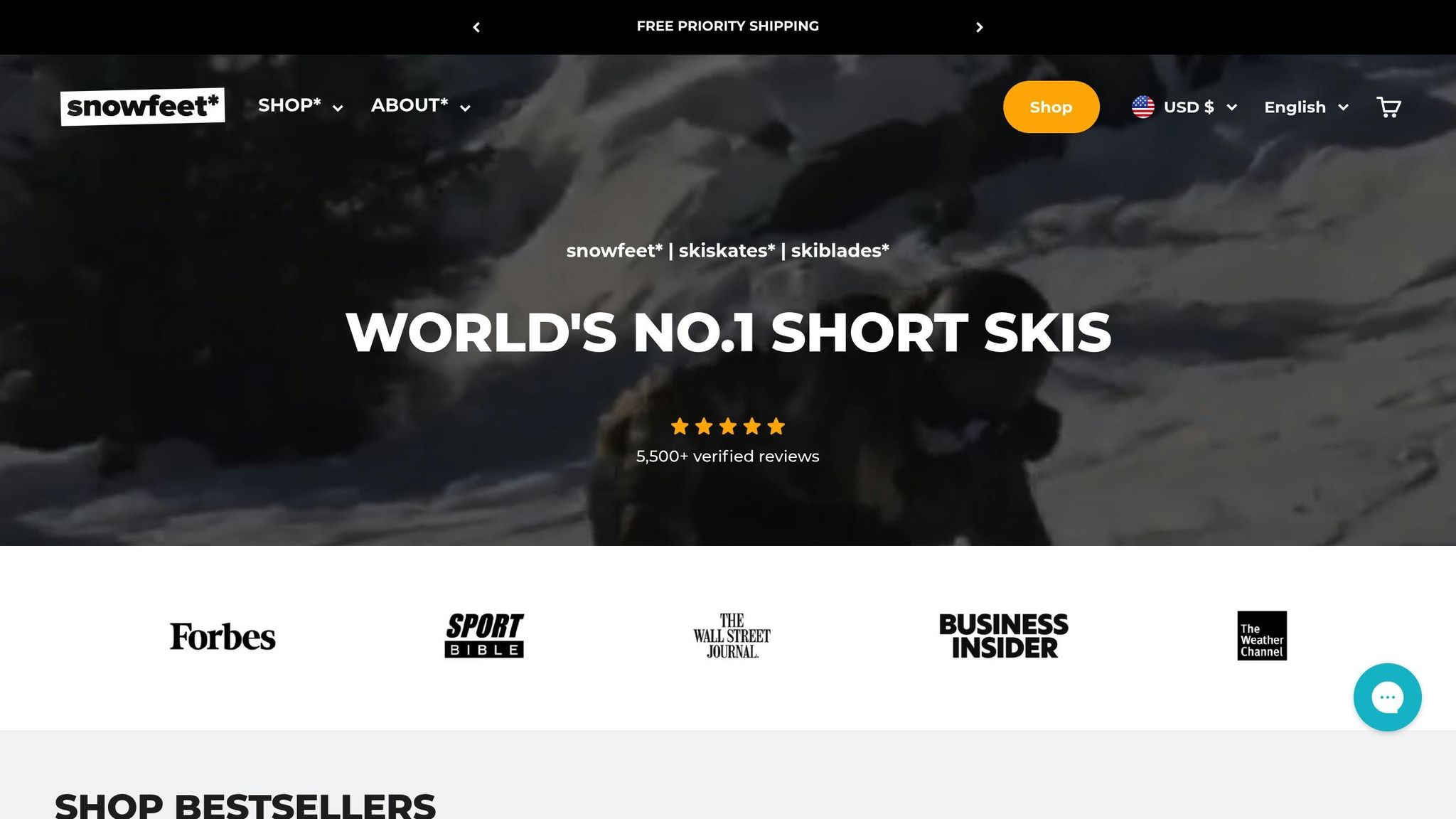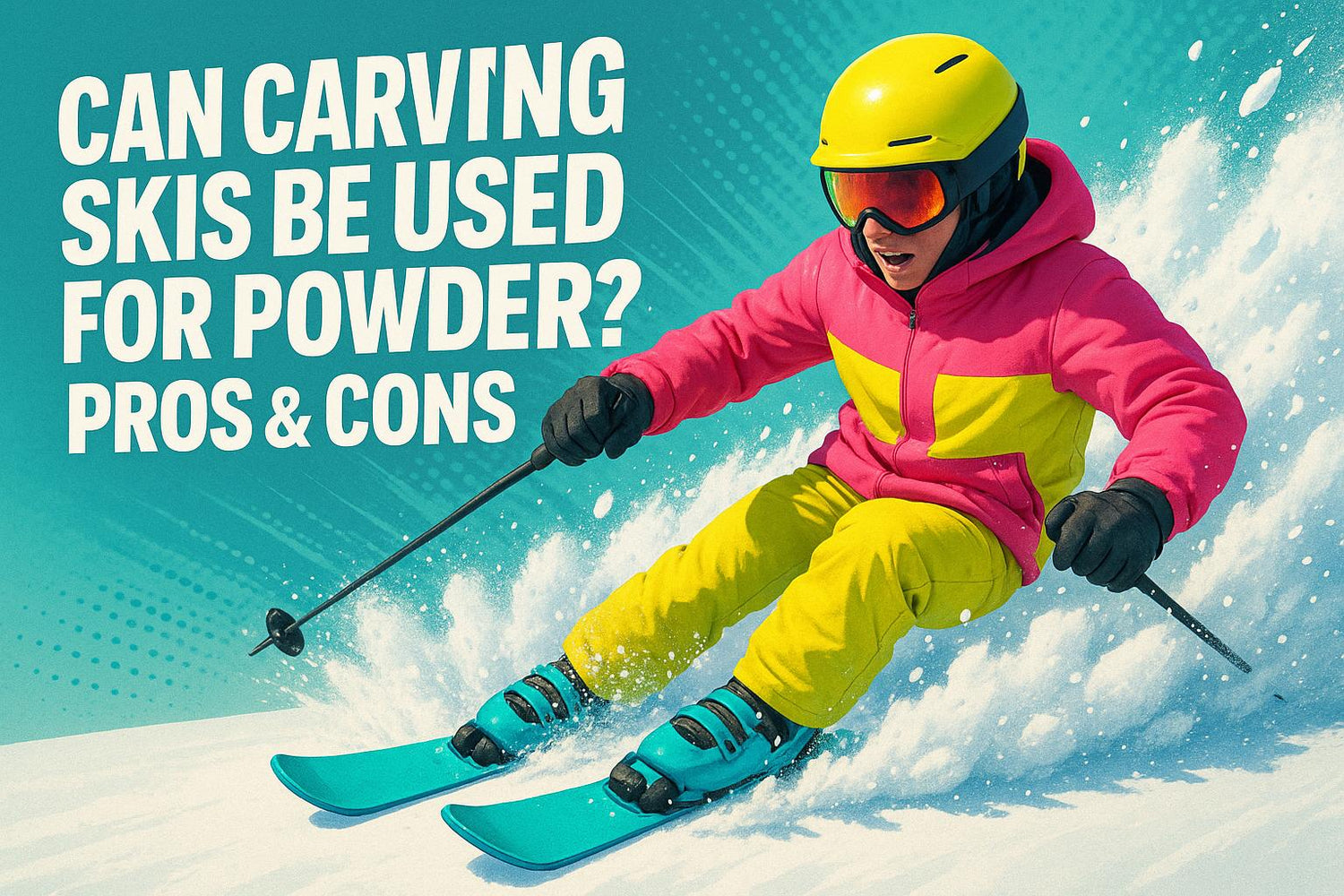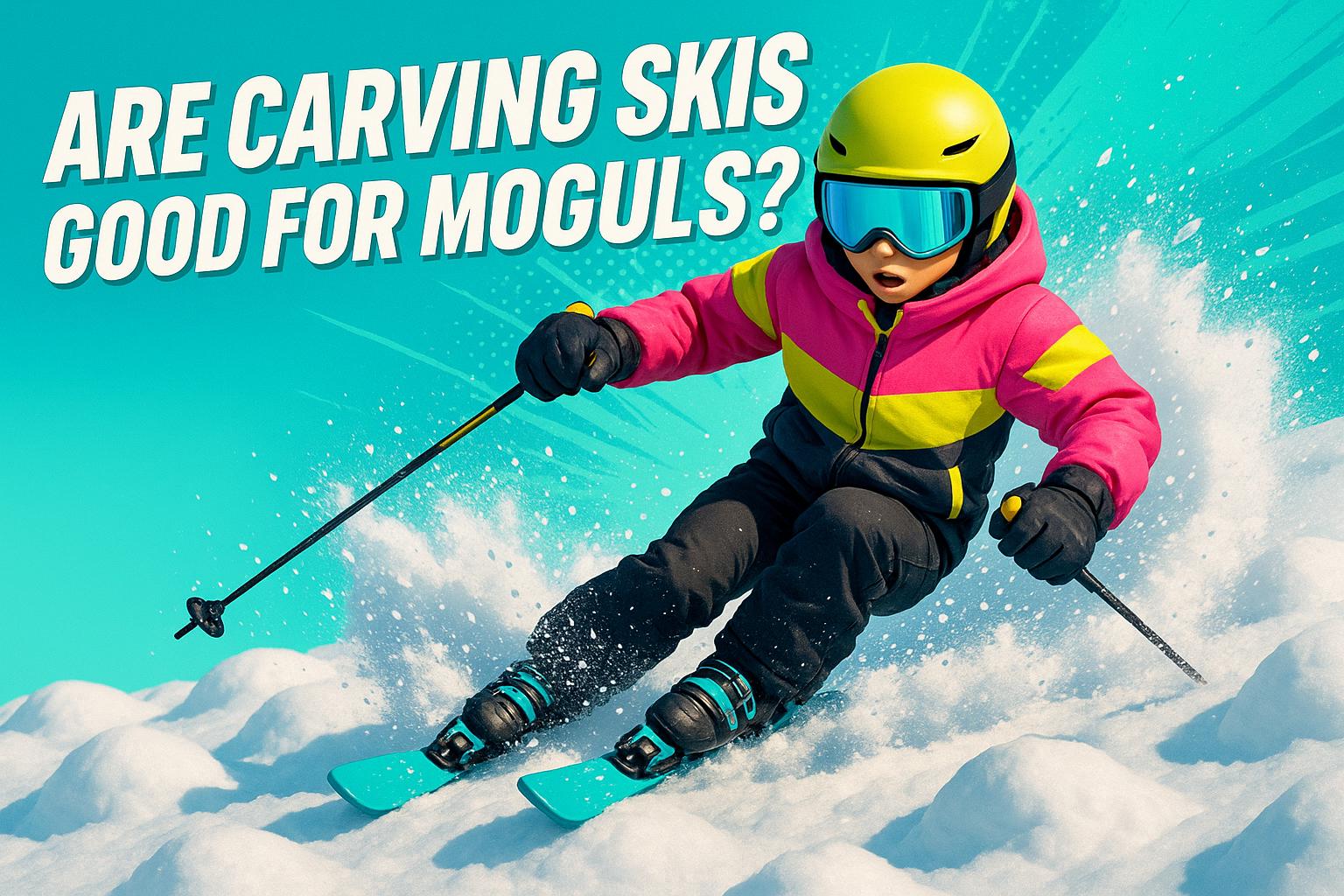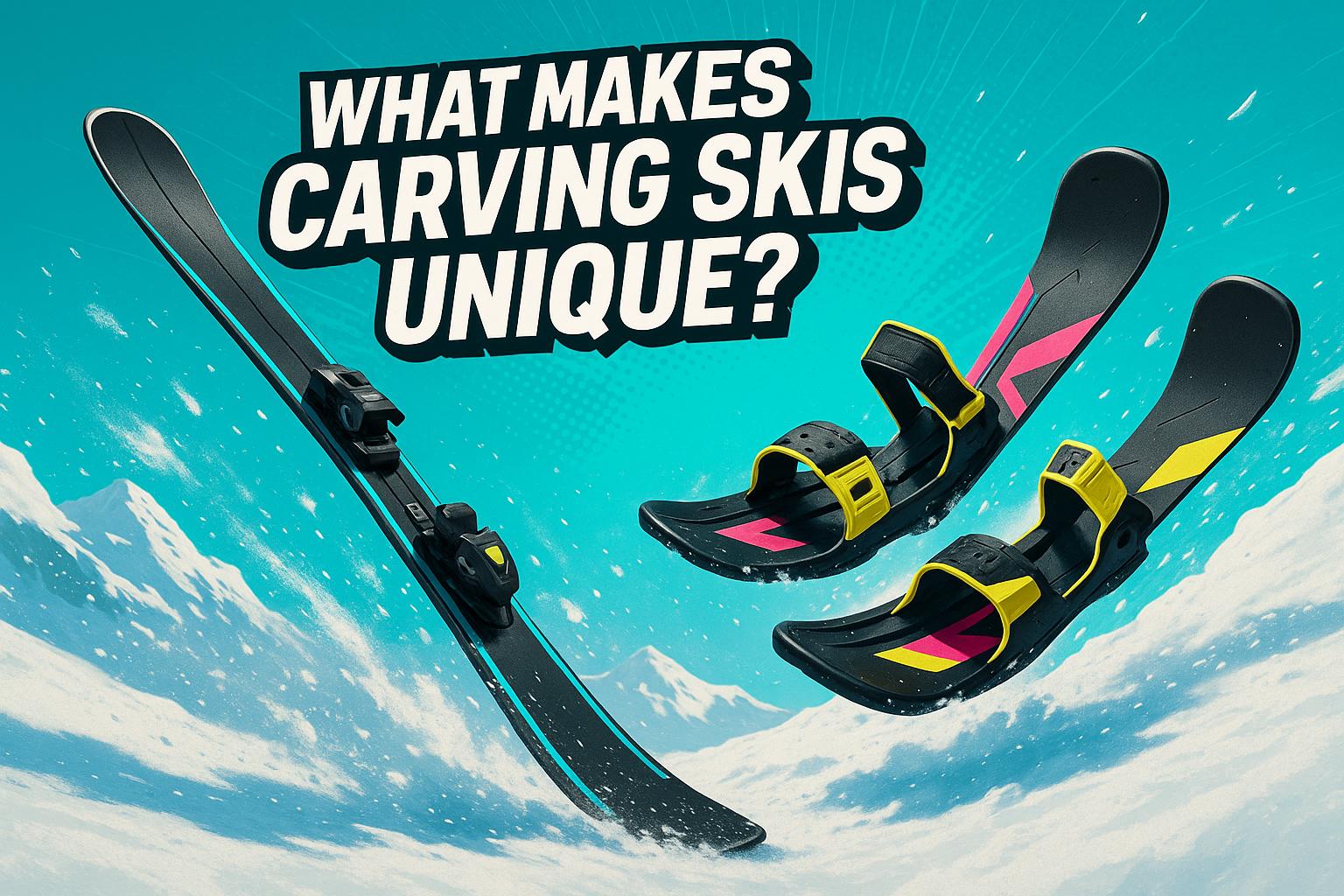Gli sci carving possono tecnicamente essere usati nella POWDER, ma non sono ideali. Il loro design stretto (65-80 mm di larghezza al centro) e il profilo rigido li rendono ottimi per piste battute ma difficili nella neve profonda. Affondano invece di galleggiare, rendendo le curve più difficili e faticose. Gli sci da POWDER (90-120+ mm di larghezza al centro) sono molto più adatti alla neve profonda, offrendo migliore galleggiamento e manovrabilità più facile. Se vuoi qualcosa di più leggero e portatile, i prodotti Snowfeet*, come gli Skiblades (65-99 cm), sono un'ottima opzione. Sono compatti, funzionano bene nella POWDER e sono adatti ai principianti.
Punti Chiave:
- Sci Carving: Stabili ad alta velocità, precisi su neve mista, ma affondano nella POWDER profonda.
- Sci da POWDER: Galleggiano senza sforzo ma possono sembrare ingombranti e richiedono più abilità.
- Snowfeet*: Compatti, versatili e facili da imparare, con ottime prestazioni nella POWDER.
Consiglio Rapido: Se scii spesso nella POWDER, evita gli sci carving. Scegli sci da POWDER o Snowfeet* per un'esperienza migliore.
Sci nella POWDER con sci carving a Niseko, Giappone
Come si comportano gli Sci Carving nella POWDER
Portare gli sci carving nella POWDER può essere un'esperienza mista. Pur offrendo alcuni vantaggi inaspettati per sciatori esperti, i loro limiti diventano evidenti con l'aumentare della profondità della neve.
Vantaggi degli Sci Carving nella POWDER
Gli sci carving hanno qualche asso nella manica, anche nella POWDER, specialmente per chi sa come usarli.
Un beneficio notevole è la stabilità ad alta velocità. Grazie alla loro costruzione rigida e al controllo preciso dei bordi, gli sci carving permettono agli sciatori esperti di mantenere il controllo a velocità più elevate, anche su neve più morbida. Questa stabilità deriva dagli stessi elementi di design che li fanno brillare sulle piste battute: un sidecut pronunciato e una struttura rigida che resiste alla flessione.
Un altro vantaggio è il controllo del bordo. Su superfici dove la POWDER si mescola con neve compatta o strati crostosi formati dal vento, i bordi affilati degli sci carving possono aggrapparsi meglio rispetto ai bordi più morbidi degli sci specifici per POWDER.
"Questo è uno strumento preciso e specializzato che non tollera gli sciocchi. È uno sci eccezionale, ma esigente, per esperti focalizzati sul frontside che cercano di tracciare archi stretti su neve dura e piste ripide." - Dave Wolf, Guida Alpina e Istruttore di Sci
Ma questi vantaggi svaniscono rapidamente man mano che la neve si fa più profonda.
Problemi degli Sci Carving nella Neve Profonda
Gli sci carving presentano una serie di sfide nella POWDER, e questi problemi diventano ancora più evidenti in condizioni di neve profonda.
Il più grande svantaggio è la scarsa galleggiabilità. Con vite strette che vanno da 65 a 85 mm, gli sci carving non offrono molto sollevamento nella neve soffice. Affonderai più in profondità, facendo sentire ogni curva come un allenamento.
Poi c'è la mancanza di profilo rocker. A differenza degli sci POWDER che presentano una punta e una coda arcuate verso l'alto per scivolare sulla neve soffice, gli sci carving mantengono un design tradizionale a camber. Questo spinge le punte nella neve, trasformando il progresso in una fatica.
Infine, ci sono limitazioni tecniche. Le curve rapide e decise in cui gli sci carving eccellono sulle piste battute non si traducono bene nella POWDER. La loro posizione stretta e gli angoli aggressivi delle lamine spesso ti fanno lottare contro gli sci invece di fluire con il terreno.
Modifiche Tecniche per gli Sci Carving
Se sei determinato a portare gli sci carving nella POWDER, dovrai modificare il tuo approccio. Sebbene questi aggiustamenti possano aiutare, non eguaglieranno la facilità d'uso degli sci progettati per la POWDER.
Per aumentare la galleggiabilità, sposta il peso per mantenere le punte sollevate. Rallenta le curve per lasciare che gli sci lavorino come una piattaforma unica e mantieni una velocità moderata per trovare un equilibrio tra controllo e sollevamento.
Effettuare aggiustamenti della posizione può anche migliorare la stabilità. Una posizione leggermente più ampia del solito può aiutarti a mantenere l'equilibrio in condizioni di POWDER imprevedibili.
"Una volta che mi sono abituato alla punta sovradimensionata e ho regolato di conseguenza l'inizio della curva, ho apprezzato l'accessibilità di questo strumento di precisione." - David Wolf, Istruttore di Sci e Guida AMGA
Anche con questi aggiustamenti, gli sci carving non possono competere con la galleggiabilità e la manovrabilità senza sforzo di attrezzature come gli Skiblades Snowfeet*, che eccellono nella loro gamma compatta da 65 a 99 cm. Se la POWDER è il tuo parco giochi, l'attrezzatura progettata appositamente è la scelta giusta.
Confronto dell'Attrezzatura: Sci Carving vs Snowfeet* vs Sci POWDER

Quando scegli l'attrezzatura per le giornate di POWDER, gli sci carving, i prodotti Snowfeet* e gli sci POWDER offrono ciascuno qualcosa di diverso. Ma uno si distingue per la sua versatilità e facilità d'uso.
Confronto delle Prestazioni
Gli sci carving, con la loro vita stretta (≤84 mm), tendono ad affondare nella POWDER, rendendoli meno ideali per la neve profonda. Gli sci POWDER, invece, con la loro vita larga (≥112 mm), scivolano senza sforzo sulla POWDER. I prodotti Snowfeet*? Trovano un equilibrio con il loro design compatto e leggero, offrendo una buona galleggiabilità nella neve.
Sulle piste battute, gli sci carving sono fulminei e reattivi, ma faticano fuori pista. Gli sci POWDER, pur essendo fantastici nella neve profonda, possono risultare ingombranti in spazi ristretti. I prodotti Snowfeet* rimangono agili su una varietà di terreni, offrendoti flessibilità sia che tu sia su una pista o su un sentiero escursionistico.
I requisiti di abilità variano anche. Gli sci carving e POWDER richiedono un certo livello di esperienza per essere gestiti bene, mentre i prodotti Snowfeet* sono adatti ai principianti e richiedono istruzioni minime.
Quando si tratta di comodità, gli sci tradizionali richiedono scarponi specializzati e sono più adatti allo sci in località turistiche. I prodotti Snowfeet*, invece, funzionano con normali scarpe invernali o scarponi da snowboard, aprendo possibilità di utilizzo su piste da sci di fondo, colline nel cortile o persino sentieri escursionistici.
Ecco una rapida panoramica di come si confrontano queste opzioni:
Tabella di confronto dell'attrezzatura
| Caratteristica | Sci da carving | Prodotti Snowfeet* | Sci da POWDER |
|---|---|---|---|
| Galleggiamento in POWDER | Scarso (vita 84 mm o meno) | Buono (design compatto e leggero) | Eccellente (vita 112 mm+) |
| Manovrabilità | Ottimo sulle piste battute; limitato fuori pista | Altamente agile su terreni vari | Lento da un bordo all'altro |
| Portabilità | Ingombrante; necessita di portapacchi da tetto | Si adatta a uno zaino | Ingombrante; necessita di portapacchi da tetto |
| Fascia di prezzo | $400–$800+ | $150–$490 | $500–$1.200+ |
| Curva di apprendimento | Da moderata ad alta | Facile; istruzioni minime | Da moderata ad alta |
| Compatibilità degli scarponi | Solo scarponi da sci | Scarpe invernali o scarponi da snowboard | Solo scarponi da sci |
| Versatilità del terreno | Solo piste battute | Piste, sentieri, cortili | Focus sulla neve profonda |
Questa tabella evidenzia come i prodotti Snowfeet* eccellano in aree come portabilità, facilità d'uso e versatilità - rendendoli una scelta eccezionale per molti.
Perché i prodotti Snowfeet* funzionano meglio
Analizzando più a fondo il confronto, i vantaggi dei prodotti Snowfeet* diventano ancora più evidenti. Con oltre 5.500 recensioni verificate e valutazioni quasi perfette, questi mini sci hanno dimostrato il loro valore.
Convenienza è un fattore importante. Gli sci carving tradizionali di marchi come Rossignol o Atomic possono costare tra $600 e $800, senza contare scarponi e attacchi. I Mini Ski Skates Snowfeet*, invece, partono da soli $150, con opzioni premium come gli Skiblades che arrivano fino a $490.
La portabilità è un altro elemento che cambia le regole del gioco. A differenza degli sci tradizionali che richiedono portapacchi e borse ingombranti, i prodotti Snowfeet* sono abbastanza compatti da entrare in uno zaino. Questo rende le avventure spontanee molto più semplici.
E poi c'è la versatilità. Mentre gli sci carving di marchi come Head o Elan sono per lo più limitati alle piste battute, i prodotti Snowfeet* brillano su sentieri escursionistici, percorsi da sci di fondo e persino sulla collina per slittini nel tuo quartiere.
"Questi skiblades sono così divertenti e facili da controllare. Non tornerò mai più agli sci normali." – Andrew B.
Un altro grande vantaggio? Sono incredibilmente facili da imparare. Mentre padroneggiare lo sci POWDER con l'attrezzatura tradizionale può richiedere anni, la maggior parte degli utenti Snowfeet* si sente sicura dopo poche ore.
"Un vero cambiamento di gioco! Sono leggeri, veloci e incredibilmente divertenti da usare." – Nathan F.
Nonostante le loro dimensioni, i prodotti Snowfeet* sono progettati per performare. Ad esempio, i loro skiskates hanno un nucleo in legno resistente, simile agli sci tradizionali, offrendo un'ottima presa e stabilità nelle discese ripide.
Oh, e non preoccuparti delle regole del resort - la maggior parte delle stazioni sciistiche ora permette questi "short skis", e i loro bordi metallici rispettano gli standard di sicurezza.
sbb-itb-17ade95
Pro e contro: sci carving nel POWDER
Usare gli sci carving nel POWDER comporta una serie di compromessi, che diventano evidenti quando sei nella neve profonda.
Pro degli sci carving nel POWDER
Un grande vantaggio? La familiarità. Se sei abituato agli sci carving, la tua memoria muscolare entra in gioco quando affronti il POWDER, rendendo la transizione più facile. Sono anche molto stabili ad alte velocità, grazie alla loro flessibilità più rigida, il che può essere di grande aiuto su pendii più ripidi. Inoltre, la loro precisione è ottima per curve rapide, specialmente quando le condizioni sono un mix di neve dura e soffice.
Contro degli sci carving nel POWDER
Detto questo, gli sci carving hanno le loro difficoltà nella neve profonda. Il loro design più stretto non offre molta galleggiabilità, quindi tendono ad affondare, il che significa che dovrai fare uno sforzo extra per restare a galla. Questa costruzione stretta rende anche le curve strette su terreni variabili più complicate. E non dimentichiamo che sciare nel POWDER con gli sci carving richiede un ritmo più lento e un equilibrio eccellente, cosa che può essere stancante se non sei abituato.
Snowfeet* vs Sci Carving nel POWDER
Ecco dove i prodotti Snowfeet* brillano - affrontano direttamente le sfide degli sci carving. Con un design compatto e leggero, offrono una galleggiabilità molto migliore nella neve soffice, rendendo le giornate di POWDER molto più divertenti. Sono anche super facili da usare, quindi non dovrai ripensare completamente la tua tecnica.
Un altro punto a favore di Snowfeet*? L'efficienza energetica. Puoi sciare più a lungo senza sentirti esausto. Sono anche versatili - non sei bloccato al resort. Snowfeet* funziona altrettanto bene su piste battute, POWDER, sentieri escursionistici o anche sulla collina del tuo giardino. E mentre padroneggiare lo sci su POWDER con gli sci carving può richiedere anni, i prodotti Snowfeet* si imparano molto più rapidamente.
Infine, quando si tratta di costo e portabilità, Snowfeet* fa la differenza. Gli sci carving possono essere costosi e difficili da trasportare, ma i prodotti Snowfeet* sono economici e abbastanza piccoli da entrare in uno zaino. Perfetti per inseguire il POWDER fresco ovunque cada.
Scegliere l'attrezzatura da sci per POWDER: perché Snowfeet* è la scelta migliore
Cosa considerare quando si sceglie l'attrezzatura per il POWDER
Scegliere l'attrezzatura giusta per lo sci su POWDER può fare la differenza nella tua esperienza sulle piste. Un fattore chiave da considerare è il tipo di terreno che affronterai - che si tratti di bowl incontaminati fuori pista, discese di POWDER in resort o una combinazione di condizioni. Gli sci tradizionali da POWDER tendono a essere larghi e lunghi, offrendo stabilità nella neve profonda, ma hanno un grande svantaggio: non sono esattamente facili da trasportare.
Il tuo livello di abilità è un altro fattore importante. Se sei alle prime armi, evita sci oltre i 180 cm. Questi sci più lunghi richiedono tecnica avanzata e forza fisica, rendendo l'apprendimento molto più difficile. Vale anche la pena pensare a quanto deve essere flessibile la tua attrezzatura. Cerchi qualcosa dedicato ai giorni di POWDER, o vuoi un'attrezzatura che possa affrontare una varietà di condizioni?
Non sottovalutare peso e portabilità. Gli sci tradizionali per POWDER possono essere pesanti e scomodi da trasportare, cosa non ideale quando insegui il POWDER in diverse località. Qui entrano in gioco design innovativi come Snowfeet*, che offrono opzioni leggere e compatte molto più facili da gestire.
Prodotti Snowfeet*: La Scelta Migliore per la Maggior Parte degli Sciatori
Ecco dove Snowfeet* si distingue. I loro design compatti e leggeri sono una ventata d'aria fresca per gli sciatori che vogliono versatilità senza complicazioni. A differenza dei marchi tradizionali che si attengono al pensiero "più grande è meglio", Snowfeet* dimostra che sci più piccoli possono offrire altrettanto divertimento - se non di più. La loro gamma include tutto, dai Snowfeet Mini Ski Skates agli Snowfeet Short Skis, offrendo opzioni che l'attrezzatura tradizionale non può eguagliare.
Prendi ad esempio lo Snowfeet POWDER. Con soli 99 cm, è fatto su misura per lo sci su POWDER. La sua dimensione compatta lo rende abbastanza leggero da mettere nello zaino, e gli sciatori intermedi possono prenderci la mano rapidamente. Confrontalo con le attrezzature tradizionali, che spesso richiedono un investimento finanziario maggiore e sono molto meno portatili.
L'attrezzatura Snowfeet* ha anche una curva di apprendimento super breve. Mentre padroneggiare lo sci su POWDER con sci tradizionali lunghi può richiedere stagioni, la maggior parte delle persone si sente a proprio agio usando i prodotti Snowfeet* dopo poche discese. Questo significa meno tempo a lottare e più tempo a godersi le piste.
Snowfeet*: Cambiare gli Sport Invernali
Snowfeet* non si limita a vendere attrezzatura - sta cambiando il modo in cui pensiamo agli sport invernali. L'azienda, fondata da Zbynek e Michael, sta persino pionierizzando un nuovo sport chiamato skiskating. Hanno grandi sogni, come vedere lo skiskating arrivare un giorno alle Olimpiadi.
Ciò che distingue Snowfeet* è il loro approccio. Sfida la vecchia convinzione che sci più lunghi siano automaticamente migliori per stabilità e velocità. Invece, si concentrano nel rendere lo sci più divertente, accessibile e versatile per tutti. Offrendo opzioni più piccole, più economiche e più leggere, Snowfeet* apre le piste a chi potrebbe essere stato scoraggiato dal costo o dalla complessità dell'attrezzatura tradizionale. Non si tratta solo di equipaggiamento - si tratta di rendere gli sport invernali qualcosa che tutti possono godersi.
Conclusione: la migliore attrezzatura per lo sci nella POWDER
Sci da Carving nella POWDER: un breve riepilogo
Gli sci da carving possono essere ottimi sulle piste battute, ma non sono all'altezza nella POWDER. La loro forma stretta li fa affondare nella neve profonda, costringendoti a fare il doppio del lavoro solo per restare a galla. Certo, gli sciatori esperti possono adattare la tecnica per farli funzionare, ma onestamente, perché farlo? La fatica non vale la pena.
Gli sci da powder, invece, sono costruiti per affrontare la neve profonda con le loro strutture più larghe e profili rocker. Ma hanno i loro svantaggi - sono più pesanti, richiedono più abilità e possono essere un peso da trasportare. Qui entra in gioco un'alternativa fresca.
Perché Snowfeet* si distingue nella POWDER
I prodotti Snowfeet* rivoluzionano l'attrezzatura da sci tradizionale. A differenza degli sci da carving che faticano nella POWDER, i design Snowfeet* sono fatti per eccellere in essa. Prendi il Snowfeet POWDER (99 cm) - creato specificamente per lo sci nella POWDER. Il suo profilo più largo ti dà la spinta necessaria per "galleggiare" senza sforzo nella neve profonda, mentre il design compatto e leggero mantiene tutto agile. E a soli 490$, non è solo più facile per le gambe ma anche per il portafoglio rispetto agli sci da powder premium di marchi come Rossignol e Atomic.
"Secondo il Team Snowfeet, la larghezza extra e il design compatto degli Snowfeet Skiblades POWDER ti permettono di 'galleggiare' sulla neve profonda mantenendo un'alta reattività - offrendo un controllo e un equilibrio superiori anche in condizioni difficili."
Un altro grande vantaggio? La portabilità. L'attrezzatura Snowfeet* è abbastanza piccola da poter essere messa in uno zaino, così puoi inseguire la POWDER fresca su più montagne senza dover affrontare ingombranti portapacchi o complicati sistemi di trasporto. Questa combinazione di galleggiamento, facilità d'uso e convenienza rende Snowfeet* una rivoluzione per chi ama sciare nella POWDER ma odia le solite complicazioni.
Domande frequenti
I prodotti Snowfeet sono migliori degli sci tradizionali da carving o da powder in termini di prestazioni e facilità d'uso?
I prodotti Snowfeet uniscono design leggero, portabilità e semplicità, offrendo qualcosa di diverso dagli sci tradizionali come quelli di Rossignol o Atomic. Mentre gli sci convenzionali sono spesso pensati per condizioni specifiche e richiedono un po' più di abilità per essere gestiti, Snowfeet sono compatti e facili da trasportare, rendendoli perfetti per chi cerca un'opzione più accessibile. Anche i principianti possono prenderci rapidamente la mano, grazie al loro design intuitivo.
Gli sci tradizionali possono dominare in scenari specializzati o orientati alle prestazioni, ma Snowfeet si distingue per la sua versatilità. Funzionano bene su diversi terreni, incluso il POWDER, e la loro costruzione amica delle ginocchia e facile da controllare li rende una scelta solida per sciatori casual o per chi cerca un'alternativa divertente e senza complicazioni. Con Snowfeet, gli sport invernali diventano meno intimidatori e molto più divertenti per tutti.
Posso usare gli sci da carving nel POWDER e quali aggiustamenti dovrei fare?
Gli sci da carving sono costruiti per la precisione sulle piste battute, ma con qualche aggiustamento possono funzionare anche nel POWDER. Se ti avventuri nella neve profonda, prova a scegliere sci lunghi circa 3–4 pollici in più rispetto al tuo setup da carving abituale. Questa lunghezza extra aiuta con la galleggiabilità. Inoltre, adottare una posizione leggermente più ampia e mantenere il peso centrato - o addirittura leggermente spostato all'indietro - può fare una grande differenza nel mantenere stabilità e controllo.
Detto questo, gli sci da carving non sono la scelta migliore per il POWDER. Se cerchi versatilità, i prodotti Snowfeet potrebbero valere la pena di essere considerati. Sono progettati per gestire diverse condizioni di neve con facilità. Inoltre, sono leggeri, facili da trasportare e costano meno degli sci tradizionali di marchi come Rossignol o Atomic. È un'ottima opzione se vuoi affrontare il POWDER senza dover fare grandi modifiche alla tua attrezzatura.
I prodotti Snowfeet sono adatti sia ai principianti che agli sciatori esperti su diversi tipi di terreno?
L'attrezzatura Snowfeet è un'opzione fantastica per chiunque, sia che tu sia nuovo allo sci o abbia già molta esperienza. Per i principianti, Snowfeet è una svolta - sono leggeri, facili da maneggiare e molto meno intimidatori degli sci tradizionali. Questo rende l'apprendimento dello sci più accessibile e, onestamente, più divertente. D'altra parte, se sei uno sciatore esperto, modelli come il Snowfeet PRO aggiungono un livello extra di emozione. Sono progettati per velocità, agilità e adattabilità, performando bene su tutto, dalle piste battute al POWDER leggero.
Ora, come si confrontano con i grandi marchi di sci come Rossignol, Atomic, Elan o Head? Snowfeet si distingue per la sua portabilità, semplicità e prezzo accessibile. Che tu sia un principiante o voglia rinnovare la tua routine sciistica, Snowfeet offre un approccio fresco e pratico all'attrezzatura tradizionale da sci e snowboard.
Post Correlati del Blog
- I Migliori Sci da Backcountry & Touring del 2025: Recensioni & Guida
- Si Può Fare Carving Efficacemente con gli Sci All-Mountain? Consigli per il 2025
- Gli Sci da Carving Sono Adatti per i Gobbe? La Verità sulle Prestazioni Sciistiche
- Cosa Rende Unici gli Sci da Carving? Un'Analisi Approfondita del Loro Design


































Lascia un commento
Questo sito è protetto da hCaptcha e applica le Norme sulla privacy e i Termini di servizio di hCaptcha.